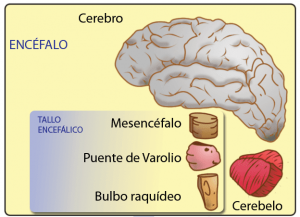Midbrain - Characteristics and Functions


Written and verified by the psychologist Sergio De Dios González
The midbrain is an essential part of the nervous system and the various functions of the human body are possible thanks to it. This is because it’s one of the brain structures that communicates with the main parts of the central nervous system.
It lives in the middle of the brain, hence the name “midbrain”. Thus, it connects the pons and the cerebellum with the diencephalon.
In addition, it’s made up of various structures, all related to motor and sensory functions. In this article, we talk about the characteristics and functions of this small but fundamental part of the brain.
Midbrain structure
The midbrain is the structure in the middle of the brain that extends from the diencephalon to the bump. In addition, its shape is similar to a trapezoid, only with a narrow base and a tiny hole that runs through it. This is known as Silvio’s hole.
Externally, one can only appreciate its anterior face. But you must lift the cerebellum to see the temporal and occipital lobes and the cerebellum.
The pons is the lower limit of the midbrain, while its upper limit is in the continuation of the nerve fibers of the optic nerve, also called optical bands. Around the frontal lobe, with the interpeduncular fossa; it reaches the pineal gland on the back.
The functions of the midbrain
The main structures of the midbrain are the tegmentum, the tectum, and the cerebral peduncles. Here’s a description of each one of them.
Tegmentum
Located in the dorsal area of the midbrain. It consists of three parts:
- Black matter. The upper part of the midbrain, between the brain peduncles and the brain tegmentum. Thus, it’s a motor nucleus, made up of the compact and reticular zone. In addition, the compact zone contains melanin pigments and, given it’s the main neurotransmitter, contains dopamine. The reticular zone doesn’t have melanin, but an iron-containing pigment whose main neurotransmitters are: GABA and acetylcholine.
- Periaqueductal gray matter. You can find it in the subependymal region. It has the shape of an envelope. Also, it contains fundamental cranial nuclei (of II, IV, and V pair) in its most central part. In addition, it participates in the modulation of pain and anxiety.
- Red core. Located in the center of the midbrain tegmentum, on both sides of the midline. Furthermore, it consists of a cluster of neurons associated with extrapyramidal pathways. Its reddish color is due to vascularization and to the cytoplasmic pigments that contain iron.
Tectum
This means “roof” in Latin and constitutes the posterior portion of the cerebral aqueduct. Its main structures are:
- The inferior colliculus, which is responsible for the processing of the auditory pathways, can establish the analysis and detection of auditory stimuli. Therefore, they’re related to the detection of sound, its frequency analysis, and the interaural differences in intensity and time.
- The superior colliculus is connected to the lateral geniculate body by the superior cerebellar peduncles. In addition, they’re centers of sensory integration and receive visual information. They also intervene in the neck, head, and eye movements.
Brain peduncles
These are two white nerve cords. Also, they’re separated from each other by the interpeduncular fossa. They live in the upper area of the brain stem, above the annular protuberance and disappear in the hemispheres.
Their main function is to maintain communication between the midbrain and the brain. In addition, brain peduncles are made up of nerve fibers that include:
- The corticopontine tract, which joins the cerebral cortex with the pons.
- The corticospinal tract links the cerebral cortex with the spinal cord.
However, they’re not the same as cerebellar peduncles. The interpeduncular fossa is between them and separates them. In addition, the black substance on the dorsal and ventral side of each peduncle keeps them apart.
Midbrain pathology
Various pathologies can manifest when something fails in the midbrain. This is because it’s a fundamental zone for certain processes. These are some of the consequences of a malfunction:
- Parkinson’s disease is a chronic and degenerative disorder. Furthermore, it leads to a progressive loss of the ability to coordinate movements. Also, it manifests with symptoms such as muscle stiffness, tremors, irritability, bradykinesia, depression, swallowing difficulties, hyposmia, and cognitive impairment, among others. This condition is related to the midbrain because it contains a black substance that’s responsible for movement control and coordination through neurotransmitters such as dopamine.
- Alzheimer’s disease is a type of cognitive impairment that causes problems with memory, thinking, and behavior. Symptoms develop slowly and worsen over time until they interfere with a person’s daily routine. However, as Xavier Girones, Arantxa Guimerà, and Félix F. Cruz Sánchez suggest in their article published in the Revista Española de Patología (In English: The Spanish Journal of Pathology), one of the possible causes of Alzheimer’s disease is neurofibrillary degeneration. It happens in various parts of the brain, especially around the midbrain.
- Parinaud’s syndrome, also known as a dorsal mesencephalic syndrome, was obviously named after Henri Parinaud (considered the father of ophthalmology), is a group of eye movement disorders. The main cause is injuries to the upper midbrain region. In addition, a person with this syndrome may present eye paralysis, nystagmus, and eyelid retraction, among other symptoms.

Conclusion
The midbrain is the link that connects various parts of the brain to each other. Due to the amount and complexity of inputs and outputs it has, any brain accident could damage it. This is because it’s an axis where fundamental unions for the human body converge.
All cited sources were thoroughly reviewed by our team to ensure their quality, reliability, currency, and validity. The bibliography of this article was considered reliable and of academic or scientific accuracy.
- Bear, M. F. Connors, B. W., Paradiso, M.A., Nuin, X. U., Guillén, X. V. & Sol Jaquotot, M. J. (2008). Neurociencias: la exploración del cerebro. Wolters Kluwer/Lippincott Williams & Wikins.
- Guimerà, A., Gironès, X., & Cruz- Sánchez, F.F. (2002). Actualización sobre la patología de la enfermedad de Alzheimer. Revista Española de patología, 35 (1), 21-41.
This text is provided for informational purposes only and does not replace consultation with a professional. If in doubt, consult your specialist.








